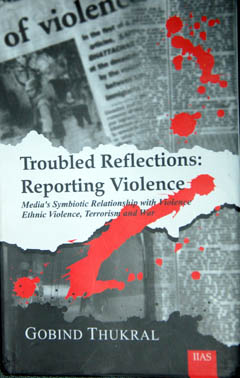Media under the scanner
Reviewed by Sarbjit Dhaliwal
The Tribune: Sunday, January 24, 2010
Troubled Reflections: Reporting Violence — Media’s Symbiotic Relationship with Violence, Ethnic Violence, Terrorism and War
By Gobind Thukral.
Indian Institute of Advanced Studies, Shimla.
Pages 214. Rs 495.
BE it terrorism, war or ethnic conflict, violence has become a world phenomenon. From AK-47s to bomb blasts, to mid-air hijackings and human bombs, the world has seen rapidly changing phases and faces of terrorism that has become a central issue across the globe. Also, wars have become more mechanised and deadly with the use of missiles, laser-guided precision bombings.
Punjab was one of the main hot spots of the world as it remained neck-deep in firestorms of militant violence for about two decades, starting from the 1980s to late 1990s. There was hardly any person, who remained unaffected, one way or other, during the turbulent period. Several state and non-state actors were involved in the violence.
firestorms of militant violence for about two decades, starting from the 1980s to late 1990s. There was hardly any person, who remained unaffected, one way or other, during the turbulent period. Several state and non-state actors were involved in the violence.
The author is a seasoned journalist and the book focuses on how media reported the violence during the violent era in Punjab. Through this book, one can virtually relive that era as it has been loaded with facts and figures, critical analysis and personal experiences related to the events, including the role of politicians, bureaucrats, police officials and others. It has a far-wider perspective that goes beyond the focus on Punjab.
Thukral, who watched the Punjab scene from close quarters, has not shown undue love to the profession he belongs. He has written the book with a straight non-sparing approach to call spade a spade. And he has broken many commonly-held perceptions such as that media provides oxygen to terrorism.
"Reporting violence in Punjab was one of the toughest assignments for any journalists. As green fields of Punjab turned red with the blood of the innocent and not so innocent, journalists, at the receiving end of the morbid state and the trigger-happy melancholic militants, found truth hard to come by," writes Thukral. Violence had deep roots in the politics of the state where some newspapers had openly played a communal game for a long time, he asserts.
The first part of the book is about the media machine and how newspapers are structured and how they functioned, while the second part is about the crisis in Punjab.
Ownership patterns, structures and the kind of commitment to journalism, all count to characterise and differentiate one newspaper from another. Radio and television in those days in Punjab were dishing out a drab propaganda and when the militants came with guns, these two institutions wilted.
The media can colour events by reporting these or by ignoring them. By being selective, if often misinforms and acts as a propaganda tool. For instance, Thukral writes that the Anandpur Sahib Resolution adopted by the Akali Dal was turned into a highly misunderstood document, courtesy some mainline newspapers which reported events in such a manner that entire Sikh community was painted as violent one.
The purpose of journalism is to explain the meaning of events as they unfold everyday. While reporting any violent conflict, terrorism, ethnic violence or war, the media is bound to suffer from many infirmities. In any armed conflict situation, the two sides involved rarely speak truth. Facts are often twisted to suit their needs. It is deception, subterfuge and damn lies that become plentiful in such situations.
When Punjab was aflame, the youth who took to guns called the Indian security forces and their opponents tyrants and killers. For the forces and establishment, these young men were simple terrorists and enemies of the nation.
In case of war between the two nation-states, the media becomes a part of war effort. Serious questions about the desirability or inevitability of such war or the political games behind such wars are rarely raised. To question the genuineness of the armed conflict is considered anti-national and unpatriotic.
How the media changes perceptions could be, according to Thukral, illustrated by how a section of the mainstream media reported the tragic events in Punjab. Julio Riberio was brought to head the beleaguered Punjab police in 1986. The journalists repeatedly asked Riberio about his plans to tackle the militancy. One newspaper reported that Riberio wanted to adopt a bullet-for-bullet policy. Riberio later disclosed that he never made such statement and words were put into his mouth. He did not find much of the press honest enough in reporting the violence in Punjab.
Thukral has given another instance that how the Akali leader Harchand Singh Longowal’s statement to hold protest during the Asian Games in 1982 was distorted by an agency by reporting that Akalis would gherao the Asian Games. Next day it made headlines and resulted into the stopping of Sikhs entering Delhi and even Haryana. The maltreatment of Sikhs during the Asian Games further alienated them and added fuel to the ongoing agitation.
There are many examples in the book to recount the sensational role that the media plays. "Subjectivity, ideology, predilections and profit motive in a market economy are so many other factors that colour what finally appears in the print. However, it does not mean that all that we read in the newspaper is highly coloured and no honest effort to understand the truth and to report is made. That is also there. It is a mixed bag indeed".
This book explores all the three aspects of the issue—media, militants and security forces—and will be highly useful and an eye-opener for professional journalists and academicians.